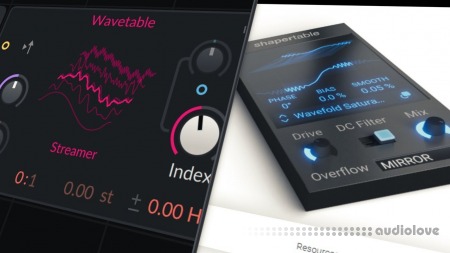Presets
Polarity Music Shapertable For Bitwig [Synth Presets]

FANTASTiC | 06 April 2024 | 252 KB
In this tutorial, I explored a unique approach to creating distortion effects in Bitwig by utilizing wave tables instead of traditional transfer curves. Here's a summary of the key points:
Introduction to a Distortion Device Using Wave Tables: Instead of adjusting a transfer curve, I demonstrated loading a wave table to morph through and create various distortion effects. This includes features like a DC filter, drive, and mix knob.
Setup in Bitwig: I used Bitwig's Polymer synthesizer with a sine wave and an FX grid. Inside the FX grid, I added a wave table oscillator and manipulated its phase to control the cycle's position, aiming for a unique distortion effect.
Implementing a DC Filter: Due to wave tables not being designed for transfer curves (which usually require the waveform to cross the zero point), I encountered issues like DC offset. To resolve this, I introduced a high-pass filter as a DC filter to eliminate low-frequency bias, ensuring the signal centers around the zero line.
Creating Distortion: By adjusting the setup, I could create various distortion effects. The flexibility of using wave tables allows for more complex and diverse distortions compared to a single static transfer curve.
Alternative Method with Transfer Curves: For those not inclined to use wave tables, I showed how to achieve a similar effect by merging multiple transfer curves and blending between them. This method also allows for creative distortion effects but through a different workflow.
Conclusion and Application: The tutorial concludes with demonstrating the practical application of these techniques to create new and unique distortion effects, highlighting the versatility and creative potential within Bitwig's environment.
This approach offers a fresh perspective on designing distortion effects, showcasing the flexibility of Bitwig's modulation capabilities and the creative possibilities when combining synthesis techniques.
home page
Introduction to a Distortion Device Using Wave Tables: Instead of adjusting a transfer curve, I demonstrated loading a wave table to morph through and create various distortion effects. This includes features like a DC filter, drive, and mix knob.
Setup in Bitwig: I used Bitwig's Polymer synthesizer with a sine wave and an FX grid. Inside the FX grid, I added a wave table oscillator and manipulated its phase to control the cycle's position, aiming for a unique distortion effect.
Implementing a DC Filter: Due to wave tables not being designed for transfer curves (which usually require the waveform to cross the zero point), I encountered issues like DC offset. To resolve this, I introduced a high-pass filter as a DC filter to eliminate low-frequency bias, ensuring the signal centers around the zero line.
Creating Distortion: By adjusting the setup, I could create various distortion effects. The flexibility of using wave tables allows for more complex and diverse distortions compared to a single static transfer curve.
Alternative Method with Transfer Curves: For those not inclined to use wave tables, I showed how to achieve a similar effect by merging multiple transfer curves and blending between them. This method also allows for creative distortion effects but through a different workflow.
Conclusion and Application: The tutorial concludes with demonstrating the practical application of these techniques to create new and unique distortion effects, highlighting the versatility and creative potential within Bitwig's environment.
This approach offers a fresh perspective on designing distortion effects, showcasing the flexibility of Bitwig's modulation capabilities and the creative possibilities when combining synthesis techniques.
home page
Only registered users can see Download Links. Please or login.


No comments yet